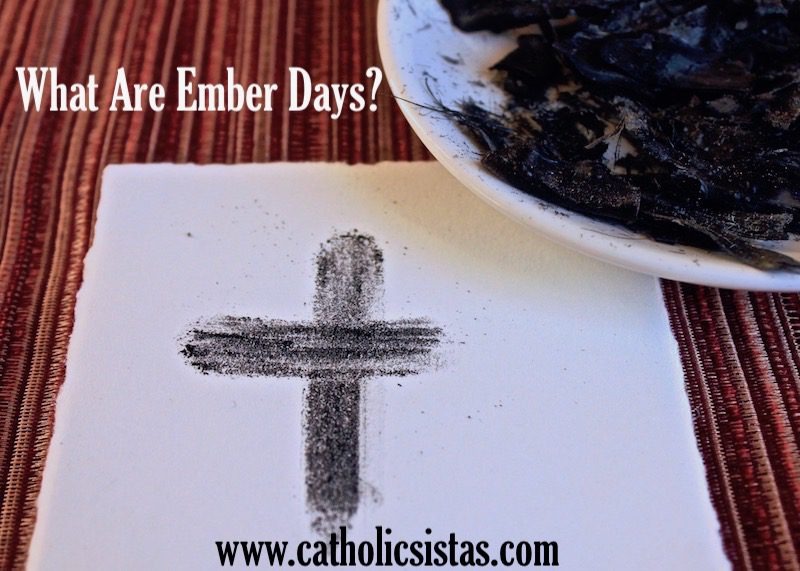
I’ve been a Catholic for over 20 years and it’s just been recently that I’ve heard of Ember Days. I’m not sure if it’s because the Catholic circle I’ve been traveling in has become more “traditional” or if it’s a reawakening for all faithful Catholics to the many beautiful, historical, and liturgically rich practices, observances, and traditions of the past. I, for one, am grateful I’ve been introduced to some of these old traditions.
What are Ember Days?
Ember Days are commemorated four times a year over three days (Wednesday, Friday, and Saturday) and mark the changing of the four seasons. They are observed the weeks following the celebrations of:
Saint Lucy’s Day for winter
1st Sunday of Lent for spring
Pentecost for summer
The Feast of the Exaltation of the Cross for fall
They are easy to remember if you think of Lucy, Ashes, Dove and Cross.
Holy Mother Church, in her wisdom, originally established Ember Days for us to focus upon God in His marvelous creation: giving Him thanks for the abundance He provides and asking His blessing upon the earth as we sow and reap in due season. As our priest so beautifully put it in one of his Ember Day homilies:
“To follow Ember Days is one of the most beautiful traditions of Holy Church. In the breadth of Tradition the cosmic calendar, that is the calendar of the earth that is independent from any kind of human observance, meets the liturgical calendar, the celebration of the mysteries of heaven in the midst of our life on earth.”
Historically Ember Days were utilized for priestly ordinations and 1st Holy Communions. Practices such as praying for priests, the holy souls in Purgatory, and almsgiving were especially encouraged. Because of their association with the seasons of the year each set of Ember Days is devoted to giving thanks and asking God’s blessing upon some agricultural aspect of the season which is paired with a particular spiritual aspect:
Winter for the olive harvest and in anticipation of the blessing of the holy oils used in anointing of the sick
Spring for the flower harvest and in remembrance of our baptism
Summer for the wheat harvest and in honor of the Holy Eucharist
Fall for the grape harvest and in honor of the Most Precious Blood
Isn’t that just beautiful?
Most recently, due to the current scandals, crisis, and confusion in the Church, Ember Days have become called upon as days for the faithful to especially pray for the cleansing and healing of the Church.
How do I observe them?
As a family we’ve just begun adding the Ember Day observances to our spiritual practices. Typically one would fast and partially abstain as an offering of penance and with the intention of giving thanks to God for His providence in creation. Ember Wednesday and Ember Saturday one would observe the usual prescribed disciplinary fast of the church of two small meals and one larger meal, abstaining from meat except at the main meal. On Ember Friday both the fast and full abstinence are the rule.
“. . . Ember Days no longer oblige one to fast and abstain. However, liturgical renewal and a deeper appreciation of the holy days of the Christian year result in a renewed appreciation as to why our ancestors spoke of a ‘fast before a feast’. There may be no great, imposed, universal fast before any feast any more, but . . . the devout will find great Christian joy in the feasts of the liturgical calendar if they freely bind themselves, for their own motives and their own spirit of piety to prepare for each Church festival by a day of particular self-denial, penitential prayer, and fasting.”
—Father Christopher Gray, homily December 22, 2019
These days of prayer, fasting, and partial abstinence are purely voluntary but such a wonderful and fruitful discipline. In just a few days the Lenten Ember Days will be upon us. I encourage you to join my family in observing this beneficial tradition: fasting and praying for good holy priests and bishops, healing in the Church, and giving thanks to God for the bounty He provides us in nature.
Sant Crux, Lucia, Cineres, Charismata Dia
Ut sit in angaria quarta sequens feria.
Which means:
Holy Cross, Lucy, Ash Wednesday, Pentecost,
are when the quarter holidays follow.
Sources used for this article:
Homily by Father Christopher Gray given on Ember Saturday, December 22, 2018
